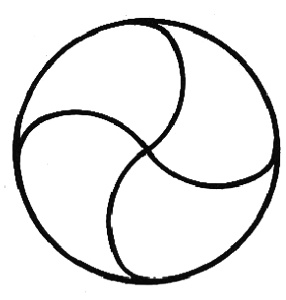The philosophy taught as the basis of Shorinji Kempo is far from the one that which is the general belief in Western societies.
Expressions like Dharma, Zazen, Zen are not expressions we use in our daily lives, and are largely empty of meaning for us.
Beginning the practice of Shorinji Kempo these and other expressions begin to take hold of our vocabulary, but often the philosophy behind them is more difficult to assimilate.
Let us, therefore, try to understand what the philosophical basis of Shorinji Kempo is: the Kongo-Zen.
The beginning
Kaiso created the Shorinji Kempo from the study of the ancient Indo-Japanese martial arts (Indian Kempo, ekkingyo) that derive from the teachings of Bodhidharma (founder of Zen).
Bodhidharma professes a purist line of Buddhism that advocated spiritual liberation through knowledge, and that this liberation could only be attained through Dhyana (Zazen) practice.
Daruma based his teachings on the belief that heaven is in the heart of man.
Kongo-Zen, the name that takes on the philosophy of Shorinji Kempo, unites in itself the vision of Bodhidharma (Zen) and Kongo which means diamond, itself combines kindness and rudeness, compassion and strength.

This dichotomy is represented in the dojo and/or dogis we use, through the circle symbol surrounding two fluid lines. The circle symbolizes the ultimate reality, which is beyond human knowledge.
Kongo-Zen does not recognize the reality that derives from the invention of the human imagination or the projection of its needs and fears.
The only power that man can use in life is knowledge; knowledge of the world and humanity as it is. By doubting to question and humbly seek knowledge free from prejudice, man will approach the truth.
Man is seen as an expression and participant in the infinite circle of reality, endowed with enormous potential. Life will be lived to its fullest extent when we use this potential to grasp wisdom, strength, courage, and love.
The flowing lines contained in the circle represent the interaction between heaven and earth, the positive – masculine -, reason/strength and the negative – feminine -, compassion/love.
“All of this symbolizes a actuality of our universe: that all reality, as we know it, is dynamically governed by continuous flux and motion of separate and unique, yet interdependent systems coexisting in unity through interaction. Thus, there is no thing, fact, being, or event which can stand by itself. ”
However, this duality is not easy for humans to assimilate, which tends to compartmentalize and classify everything around them, sometimes creating three types of conflicts:
– Mind versus matter
– Selfishness versus Altruism
– Life versus death
Mind versus Matter
The power of mind over body/matter is not always easy to explain. Some philosophies defend the primacy of mind over matter, and vice versa, yet pathological and physical studies tend to confirm this symbiosis.
The correlation between them is demonstrated, for example, when we feel overly concerned, and this over-concern causes us to lose appetite, insomnia, or ulcers.
In light of this correlation it is important for the individual to reevaluate their way of life, particularly taking into account the balance between mind and body.
Selfishness versus Altruism
Man is itself a social being; we depend on each other not only for survival reasons, but also for developmental and life-enhancing needs.
This fact is easily verified initially by the universal institution, which is the family, and historically by the congregation of human beings in ever larger groups/communities.
Relationships of interdependence require that some restrictions be placed on personal freedom in order to ensure good relations among all, so attitudes such as honesty, tolerance, impartiality and altruism must be cultivated.
This does not mean that we must submit to our individuality and always act in accordance with a group.
“Each individual must be allowed to be himself, as the universe is an interaction of unique elements.”
Different opinions and divergences are enriching, as they enable stimuli and alternatives, asking them to be analyzed demonstrating their value and truth.
The individuality, therefore, must be preserved.
Life versus Death
The universe is always changing and is not static, so Man experiences not only life and death, but countless states throughout life.
Human growth is fluid, we continually move from childhood to youth, adulthood and old age.
Man goes through changes, mentally and physically, throughout his life and every moment without, however, breaking the link between past, present and future.
“Just as a pebble thrown in to water transmits an infinite number of ripples, the present moment is a reflection of the past as well as a mirror of the future.”
Because the meaning of life is individual research, it is important to make a sincere effort to live and make every moment rewarding.
Bibliography: «What is Shorinji Kempo?», by Doshin So, October 1972, published by Japan Publications, Inc., Tokyo

